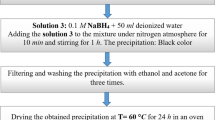Abstract
Bismuth-doped tin dioxide nanometer powders were prepared by co-precipitation method using SnCl4 and Bi(NO3)3 as raw materials. The effects of calcining temperature and doping ratio on the particle size, composition, spectrum selectivity of bismuth-doped tin dioxide and the phase transition of Bi-Sn precursor at different temperatures were studied by means of X-ray diffraction, transmission electron microscopy, ultraviolet-visual-near infrared diffuse reflection spectrum and the thermogravimetric-differential scanning calorimetry. The results show that prepared bismuth-doped tin dioxide powders have excellent characteristics with a single-phase tetragonal structure, good dispersibility, good absorbency for ultraviolet ray and average particle size less than 10 nm. The optimum conditions for preparing bismuth-doped tin dioxide nanometer powders are as follows: calcining temperature of 600 °C, ratio of bismuth-doped in a range of 0.10–0.30, and Bi-Sn precursor being dispersed by ultrasonic wave and refluxed azeotropic and distillated with mixture of n-butanol and benzene. The mechanism of phase transition of Bi-Sn precursor is that Bi3+ enters Sn-vacancy and then forms Sn-O-Bi bond.
Similar content being viewed by others
References
Gorley P M, Khomyak V V, Bilichuk S V, et al. SnO2 films: formation, electrical and optical properties [J]. Materials Science and Engineering B: Solid-State Materials for Advanced Technology, 2005, 118(1–3): 160–163.
Calestani D, Zappettini A, Lazzarini L. Structural and optical study of SnO2 nanobelts and nanowires [J]. Materials Science and Engineering C, 2005, 25(5–8): 625–630.
HE Qiu-xing, TU Wei-ping, HU Jian-qing. Advances in development of the spectrum selective nanocomposite coatings[J]. Materials Review, 2005, 19(12): 9–12. (in Chinese)
HE Qiu-xing, TU Wei-ping, HU Jian-qing. Developments of modification and dispersion of nanometer Powders in nanocomposite coatings[J]. Chemical Industry and Engineering Progress, 2005, 14(10): 1108–1112. (in Chinese)
WANG Yuan-sheng, YANG Yu-min, HUANG zhao-xin. Doping and microstructure of nanocrystalline SnO2 [J]. Chinese Journal of Materials Research, 1998, 12(5): 531–534. (in Chinese)
Leite E R, Longo E, Varela J A, et al. A new method to control participle size distribution of SnO2 nanoparticles for gas sensor applications[J]. Advanced Materials, 2000, 12(13): 965.
Aukkaravittayapun S, Wongtida N, Kasecwatin T. et al. Large scale F-doped SnO2 coating on glass by spray pyrolysis[J]. Thin Solid Films, 2006, 496(1): 117–120.
Han J B, Zhou H J, Wang Q Q. Conductivity and optical nonlinearity of Sb doped SnO2 films[J]. Materials Letters, 2006, 60(2): 252–254.
LI Wei, ZHOU Ke-chao, YANG Hua. Application research progress of bismuth oxide[J]. Journal of Materials Science and Engineering, 2004, 22(1): 154–156. (in Chinese)
Malinovskaya T D, Aparnev A I. Carbon monoxide semiconductor based on SnO2-Bi2O3 [J]. Russian Journal of Applied Chemistry, 2001, 74(11): 1864–1867.
Rose-Noelle V, Edouard C. Oxide ion transport in bismuth-based materials[J]. Materials Research Society Symposium Proceedings, 2003, 756: 95–103.
Kikuchi K, Taira K. Highly nonlinear bismuth oxide-based glass fibers for all-optical signal processing[J]. Electronics Letters, 2002, 38(4): 166–167.
WANG Bin-hua. Optical properties of nano-semiconductor-materials and their applications[D]. Chengdu: Department of Metal Materials, Sichuan University, 2003. (in Chinese)
LU Wan-zhen, YUAN Hong-fu, XU Guang-tong, et al. Modern analytical technology of near infrared spectrum[M]. Beijing: China Petrolchemical Press, 2000. (in Chinese)
Author information
Authors and Affiliations
Corresponding author
Additional information
Foundation item: Project (GC200603) supported by the Open Fund of Guangdong Provincial Key Laboratory for Green Chemicals; project supported by the Key Laboratory of Enhanced Heat Transfer and Energy Conservation of Ministry of Education of China
Rights and permissions
About this article
Cite this article
He, Qx., Tu, Wp. & Hu, Jq. Synthesis and characterization of bismuth-doped tin dioxide nanometer powders. J Cent. South Univ. Technol. 13, 519–524 (2006). https://doi.org/10.1007/s11771-006-0080-y
Received:
Accepted:
Published:
Issue Date:
DOI: https://doi.org/10.1007/s11771-006-0080-y




